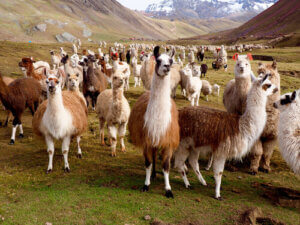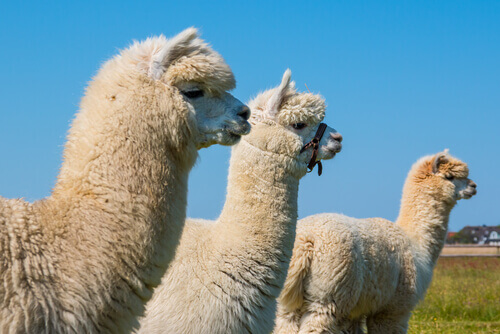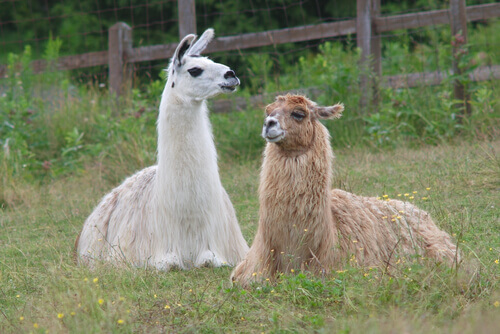The Differences Between Llamas and Alpacas

The differences between llamas and alpacas seem subtle if you aren’t familiar with these animals that inhabit Peru and Bolivia. However, they’re easier to distinguish than you may think.
Similarities between llamas and alpacas
Before listing the differences between these animals, we have to talk about their similarities. They inhabit similar habitats and are closely related to each other. Both animals belong to the camelid family and are closely related to vicuñas and guanacos, although these are wild animals.
Both alpacas and llamas have similar diets, as they’re herbivorous and feed by grazing. The two species live in herds and are domesticated animals. This means that they live peacefully alongside man. Below, you’ll discover their differences, which go beyond the physical.
The differences between llamas and alpacas
The differences between these animals are obvious to those who are familiar with them and used to seeing them. However, a person who first travels to the places they inhabit may consider them to be the same animal.
The characteristics that set them apart are also related to their relationship with man and their character, not only to their appearance. Although both are docile animals, they react differently when strangers approach them.
Height and proportions
One of the most notable differences between these animals is their size, as llamas are visibly taller than alpacas. Llamas measure around 3.9 feet to the withers, while alpacas are barely 2.9 feet long.
Llamas are also heavier. They weigh about 220 pounds, while alpacas usually don’t weigh more than 130 pounds.
The face
If you look closely at their face, you’ll find more differences between them. Alpacas have rounder faces and less sharp facial features than llamas.

Llamas have short pointy ears, while an alpaca’s are more rounded. The same goes for the muzzle, as an alpaca’s stands out more and has a more elongated appearance.
Their fiber
These animals also differ a lot in their relationship with humans. Alpaca fiber is highly coveted for being soft and light. This means that these animals have a thicker and more abundant coat than their relatives, as well as a fluffier appearance.
On the contrary, as llama fiber is rougher and more difficult to work with, they’re mostly used as working animals. They’re perfect for this, as they’re physically strong. In short, llamas have less wool (fiber) and a rougher and less friendly appearance than their relatives.
Character
Another of the big differences between llamas and alpacas is their character. Yes, both are domesticated herd animals that are curious about and interested in humans.
But alpacas are rather shy animals that flee if strangers try to get too close. They don’t like to work for humans. In fact, if they ever feel upset or angry, they could resort to spitting. However, these animals simply prefer to move away if they can.

On the contrary, llamas are more outgoing but also more stubborn. If it feels annoyed or isn’t being treated the way it wants, it won’t hesitate to spit on or kick those around it. In addition, it may decide not to work for humans or stay still or lie down, making it impossible to force it to move.
Although the differences between these animals may seem difficult to spot, you simply need to pay close attention to become aware of them. If you’re looking at one of these animals and are unsure of which one it is, look at its size and ears!
The differences between llamas and alpacas seem subtle if you aren’t familiar with these animals that inhabit Peru and Bolivia. However, they’re easier to distinguish than you may think.
Similarities between llamas and alpacas
Before listing the differences between these animals, we have to talk about their similarities. They inhabit similar habitats and are closely related to each other. Both animals belong to the camelid family and are closely related to vicuñas and guanacos, although these are wild animals.
Both alpacas and llamas have similar diets, as they’re herbivorous and feed by grazing. The two species live in herds and are domesticated animals. This means that they live peacefully alongside man. Below, you’ll discover their differences, which go beyond the physical.
The differences between llamas and alpacas
The differences between these animals are obvious to those who are familiar with them and used to seeing them. However, a person who first travels to the places they inhabit may consider them to be the same animal.
The characteristics that set them apart are also related to their relationship with man and their character, not only to their appearance. Although both are docile animals, they react differently when strangers approach them.
Height and proportions
One of the most notable differences between these animals is their size, as llamas are visibly taller than alpacas. Llamas measure around 3.9 feet to the withers, while alpacas are barely 2.9 feet long.
Llamas are also heavier. They weigh about 220 pounds, while alpacas usually don’t weigh more than 130 pounds.
The face
If you look closely at their face, you’ll find more differences between them. Alpacas have rounder faces and less sharp facial features than llamas.

Llamas have short pointy ears, while an alpaca’s are more rounded. The same goes for the muzzle, as an alpaca’s stands out more and has a more elongated appearance.
Their fiber
These animals also differ a lot in their relationship with humans. Alpaca fiber is highly coveted for being soft and light. This means that these animals have a thicker and more abundant coat than their relatives, as well as a fluffier appearance.
On the contrary, as llama fiber is rougher and more difficult to work with, they’re mostly used as working animals. They’re perfect for this, as they’re physically strong. In short, llamas have less wool (fiber) and a rougher and less friendly appearance than their relatives.
Character
Another of the big differences between llamas and alpacas is their character. Yes, both are domesticated herd animals that are curious about and interested in humans.
But alpacas are rather shy animals that flee if strangers try to get too close. They don’t like to work for humans. In fact, if they ever feel upset or angry, they could resort to spitting. However, these animals simply prefer to move away if they can.

On the contrary, llamas are more outgoing but also more stubborn. If it feels annoyed or isn’t being treated the way it wants, it won’t hesitate to spit on or kick those around it. In addition, it may decide not to work for humans or stay still or lie down, making it impossible to force it to move.
Although the differences between these animals may seem difficult to spot, you simply need to pay close attention to become aware of them. If you’re looking at one of these animals and are unsure of which one it is, look at its size and ears!
This text is provided for informational purposes only and does not replace consultation with a professional. If in doubt, consult your specialist.








